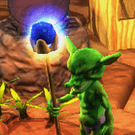Hi folks!
Today i’m trying write some vertex shader and it must fetch the diffmap for vertex displacement
i’m copy the libSolid.hlsl and doing some fixes into it.
the first of all i try to find how dx9 doing fetch from textures in vertex shader and find this tut
http.developer.nvidia.com/GPUGem … ter18.html
i find this
float4 main(float4 position : POSITION,
uniform sampler2D tex0,
so i decide just add sampler2D sDiffMap : COLOR for VS in parameters
void VS(float4 iPos : POSITION,
float3 iNormal : NORMAL,
float2 iTexCoord : TEXCOORD0,
sampler2D sDiffMap : COLOR,
#if defined(LIGHTMAP) || defined(AO)
float2 iTexCoord2 : TEXCOORD1,
#endif
#ifdef NORMALMAP
float4 iTangent : TANGENT,
#endif
#ifdef SKINNED
float4 iBlendWeights : BLENDWEIGHT,
int4 iBlendIndices : BLENDINDICES,
#endif
vertex displace
float4x3 modelMatrix = iModelMatrix;
float3 dcolor = tex2Dlod (sDiffMap, float4(iTexCoord.xy, 0,0));
float displace = (dcolor.r * cChannelFactor.r + dcolor.g * cChannelFactor.g + dcolor.b * cChannelFactor.b );
float3 dispPos = iPos.xyz + iNormal.xyz * displace * cDisplacement;
float3 worldPos = mul(dispPos, modelMatrix);
oPos = GetClipPos(worldPos);
oNormal = GetWorldNormal(modelMatrix);
oWorldPos = float4(worldPos, GetDepth(oPos));also i’m add some uniforms for vs and ps in uniforms.hlsl
uniform float4 cChannelFactor;
uniform float cDisplacement;
uniform float2 cRange;
but i’m got an editor’s crush then trying to open my scene, with object that have this custom draw tech.
i guess there not so simple way to doing fetch in dx9 ?







